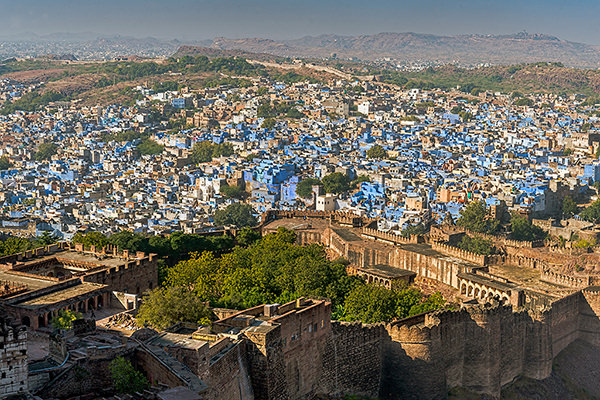CASTANETS IN THE COURTYARD
The courtyard of the castle echoes to the sound of clacking castanets. Yet, the castle is neither in Granada nor in Cordoba! Actually, another edition of the Jodhpur Flamenco and Gypsy festival had begun. In early April 2015, Spanish and Rajasthani artists performed here together for 3 days, tastefully combining local folk music and Spanish Flamenco. It seems incongruous until you realize that much of the Flamenco and Gypsy traditions of Spain have evolved from Rajasthani folk art carried to Europe by migrants from that State.
The migration occurred over several centuries while North India and Rajasthan in particular, was in a very turbulent state after the fall of the Gurjar-Parihar empire in the 11th century. But how do the seemingly diverse threads of Rajasthani Banjaras, the Romany folk, and the Meherangarh fort all fit together to weave such a fascinating tapestry? Here is the engrossing tale.

THE DESERT BLOOMS – FOUNDING OF JODHPUR
Claiming descent from the Sun-God, the Rathore Clan call themselves Suryavanshis. Driven out of Kaunaj in the 14th century their original homeland by Afghans, they settled in Pali near the present-day Jodhpur. Over time, they ousted the Pratihara rulers of Mandore, just 9 km away to establish the Marwar state. By middle of the 15th century, however, Rao Jodha, the 15th king of the clan felt the need for a more secure capital than the crumbling thousand year old fort city of Mandore.
Jodha chose the top of a 400-foot high hillock to build his fortress and the city of Jodhpur grew around it. Later the growing city spilled over into the surrounding countryside, making a part of the great Thar desert bloom. More on Jodha’s new fortress anon.
Many houses in Jodhpur are painted a vivid blue so that the city is sometimes called the blue city much like Jaipur is called the pink city. Some believe that the caste system is behind this custom as the resident Paliwal Brahmins painted their houses blue to signify their high status. Others subscribe to a more practical reason, the blue paint kept the houses cool in the hot desert sun.

FORTRESS OF THE SUN
North India was not a safe place in the mid 15th century for commoners and lords alike. Feuding kings trying to annex each other’s kingdom and marauding Afghans made everyone feel insecure. Rao Jodha too looked around the thousand-year-old crumbling Mandore fort and realized that he was quite vulnerable in his present capital.
Fortunately, only five miles away lay a rocky hill 400 feet high commanding the lucrative trade route connecting Gujarat to Delhi. Legend has it that a holy man advised Jodha to build his fortress on top of the hill. Another version states that the hermit called Cheeria Nathji or lord of the birds was already in residence on top of this hill. Jodha had to build the hermit a temple and a house inside the fort to appease his anger at being disturbed.
In order to ensure that the Gods were propitiated, the King sacrificed a man, burying him alive in the foundations of the fort. Though begun by Rao Jodha, the fort was completed some 200 years later by his descendant, Jaswant Singh.
The rich trade route between Gujarat and Delhi that lay at the foothills of the fortress provided the king and the subjects with much wealth as profits and as taxes. The king and his subjects prospered in the new city of Jodhpur.
So how did Jodha honor his ancestral Deity? He named the fort Meherangarh after the Sun God. One of the Sanskrit names for the Sun is Mihir while Garh is Sanskrit for the fort. Over time, local dialects and local ways of pronouncing Sanskrit words changed the original Mihir Garh to Meherangarh as the fort is known today. The fort and the old city are spread over 3 miles inside walls that are 120 feet high and 20 feet thick in places. The elevated location and the very thick and high walls did make the fortress invincible. Through the centuries, it has never fallen to the enemy in spite of repeated attacks.
TREASURES OF MEHERANGARH
The museum in the Mehrangarh fort is one of the most well-stocked in Rajasthan. In one section of the fort museum, there is a selection of old royal Howdahs for elephants and palanquins for royal ladies. The elaborate domed gilt Mahadol palanquin was won in a battle from the Governor of Gujarat in 1730. The museum exhibits the heritage of the Rathores in the form of arms, costumes, paintings and decorated period rooms.

The Meherangarh Trust runs the museum and repairs the fort. The trust also promotes cultural festivals and local handicrafts. Their cultural festivals also include the Flamenco festival and attract international participants and audiences.
Inside the fort are many galleries, each with a theme. The Daulatkhana or treasure room contains many examples of Mughal art while the Armory displays armor, swords shields and old guns. Swords of Akbar the Great and of Timur the Lame are preserved here. There is also a souvenir shop for visitors.
As the beat of Flamenco dies down and dark clouds obscure the Moon, you may see a shadowy figure on the ramparts. Is this the Sun-God, protector the invincible fort, or just spirit of the hapless sacrifice buried deep under the thick walls of Meherangarh fort? You decide!
Jayant Neogy’s photo-journals delight the eye and nourish the mind.
Interesting read
Beautiful pics